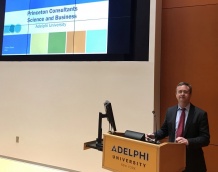Institutional investors in sustainable land-based assets around the world rely on a management firm for superior stewardship and financial yields. Over decades, one independent firm has established an innovative, disciplined approach to become a global leader in conservation, real estate management, and acquisitions and sales. Its continually changing portfolio—comprised of millions of acres worth millions of dollars—benefits a diverse clientele of public and private investors with evolving risk and return needs. In generating alpha—a return above the sector’s benchmark—the management firm balances many factors, such as short-term gains and long-term appreciation, and the environmental and financial values of its assets.
The Optimization Edge
A Blog for Business Executives and Advanced Analytics Practitioners
Technologies: Data Science, Big Data, Optimization, Machine Learning, Artificial Intelligence, Predictive Analytics, Forecasting
Applications: Operations, Supply Chain, Finance, Health Care, Workforce, Sales and Marketing

As subscription e-commerce continues to expand, Birchbox, the trailblazing subscription box service, has stood out with a strong value proposition that engages underserved, overlooked, “casual” beauty and grooming consumers, and meaningfully increases their spend in the category. Birchbox, which launched in 2010, delivers five to six samples a month, tailored to each subscriber’s needs and preferences.
A subscription box service’s operational success is powered mainly by its “black box”—the custom software solution that groups subscribers into clusters and then creates configurations of available products to send to each group of subscribers. The solution must be formulated to deliver product groupings and box creations deemed “ideal” by the company’s proprietary criteria. Additionally, the solution must accommodate meaningful business changes and scale as the service grows.

A former colleague recently offered “some controversial and unpopular advice on ultimately succeeding in academia” in University Business, which covers college and university management of enrollment, IT, facilities and academic affairs.

For years, relay trucking, in which drivers exchange trailers and/or tractors, has been a popular topic but elusive practice. On Sirius XM’s Road Dog Trucking Radio, Princeton Consultants CEO Steve Sashihara discussed the appeal of and obstacles to relays, and the confluence of technology and business factors that may lead to their increase and how that would transform long-haul trucking. Following are lightly edited excerpts from the July 16 program.

We employ a framework of 20 scorable risk factors, the “Princeton 20,” to manage our optimization projects for deployment into production. There are 10 environmental and 10 technical factors. In the previous post, I addressed the environmental risks. Following are the technical risks.

Our firm takes data-driven insights and models and brings them to the field as applications. There may be dozens or hundreds of users spread over multiple locations and working in different shifts or in different jobs, with different things to solve. Over the years we have overcome many challenges to deploying optimization and we have systematized the problems, dilemmas and mitigation techniques.
We employ a framework of 20 scorable risk factors, the “Princeton 20,” to manage our optimization projects for deployment into production. There are 10 environmental and 10 technical factors. In this post, I will address the environmental, or business, risks. In a later post, I will address the technical risks.
At Princeton Consultants, we have started to do the majority of our optimization model development using python with the pandas library (https://pandas.pydata.org/). We have successfully developed models using the Gurobi (https://www.gurobi.com/) python interface, and the docplex (http://ibmdecisionoptimization.github.io/docplex-doc/) python interface for IBM ILOG CPLEX Optimization Studio (https://www.ibm.com/products/ilog-cplex-optimization-studio). Based on these successes, we have codified our approach for rapid optimization model development. Our steps for success include:

Dave Shanno, my colleague and friend who helped jump-start my career over 30 years ago, recently passed away. Dave was a brilliant mathematician and academic researcher who especially valued the usefulness and implementation of solutions—his perspective inspired me and many others in Operations Research. Today, machine learning is just one area that is benefitting from his work. In December, 2017, I interviewed Dave for the INFORMS Oral Histories program (video and full transcript are here).

I was recently invited to speak to executives at the Retail Industry Leaders Association (RILA) about tech disruption in freight transportation. Following is a lightly edited excerpt from my presentation.
The premise of our survey was that disruption is real—it's happening. We asked a sanity question, “Do you agree?” At the close of the survey, we wrote, “We believe that disruption is creating new winners and losers. That people should look at their strategy, their sales, operations, IT. What do you think? What are you doing about it?”

Periodically we draw from other Princeton Consultants practice areas for helpful content.
When does a project go bad? Signs of trouble don’t appear in status reports until the project is well underway. After all, it takes some time for the budget to slip significantly, and even if early dates are missed, there is a bias toward explanations like “growing pains”, “the team learning to work together”, and “IT is overallocated”.

